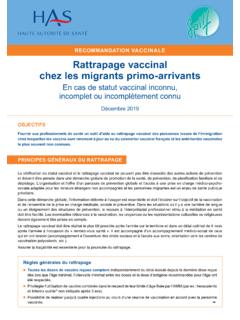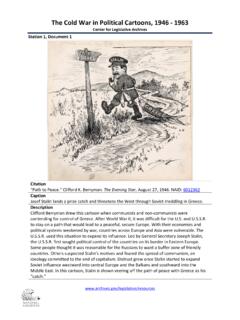Transcription of Central American Migration: Root Causes and U.S. Policy
1 Updated October 27, 2021 Central American Migration: Root Causes and PolicyRecent Trends According to a model developed by academics at the University of Texas at Austin, an estimated 311,000 people, on average, left the Northern Triangle region of Central America (see Figure 1) annually from FY2014 to FY2020, with the majority bound for the United States. Flows have varied from year to year, with an estimated 709,000 people leaving the region in FY2019 and an estimated 139,000 people leaving the region in FY2020. Surveys conducted in 2020 found many potential migrants in the region had postponed their plans in the midst of the Coronavirus Disease 2019 (COVID-19) pandemic but intended to undertake their journeys once governments lifted cross-border travel restrictions. Figure 1. Northern Triangle of Central America Source: Map Resources. Adapted by CRS. In FY2021, Border Patrol encountered nearly 684,000 foreign nationals from the Northern Triangle at the Southwest border, including 309,000 Hondurans, 279,000 Guatemalans, and 96,000 Salvadorans (see Figure 2).
2 The Border Patrol apprehended 287,000 of those individuals under Title 8 of the Code (immigration) and expelled nearly 397,000 under Title 42 of the Code (public health). Taken together, individuals from the Northern Triangle accounted for 41% of all Border Patrol encounters at the Southwest border, outnumbering Mexican nationals, who accounted for 37% of the total. Of those encountered from the Northern Triangle, about 17% were unaccompanied children, 39% were traveling with family members, and 45% were single adults. Root Causes Although motives vary by individual, difficult socioeconomic and security conditions exacerbated by natural disasters and poor governance appear to be the most important drivers of this mixed flow of economic migrants and asylum-seekers. Research suggests such flows can become self-reinforcing over time, as families seek reunification and those who leave their communities serve as examples for, and share their experiences and resources with, those who remain behind.
3 Figure 2. Border Patrol Apprehensions and Expulsions of Guatemalan, Honduran, and Salvadoran Nationals at the Southwest Border: FY2011-FY2021 Source: Border Patrol data. Note: Figures for FY2020 and FY2021 include Title 42 public health expulsions in addition to Title 8 apprehensions and are not strictly comparable to prior years. Socioeconomic Conditions Land ownership and economic power in the Northern Triangle historically have been concentrated in the hands of a small group of elites, leaving a legacy of extreme inequality and widespread poverty. Although market-oriented economic reforms in the 1980s and 1990s produced greater macroeconomic stability and facilitated the diversification of the region s once predominantly agricultural economies, those moderate economic gains have not translated into improved living conditions for many in the Northern Triangle. Analysts expect the working-age populations of all three Northern Triangle countries will continue to increase over the next two decades, since approximately 45% of Guatemalans, 42% of Hondurans, and 36% of Salvadorans are under the age of 20.
4 Without improved job creation, new workers may be forced to choose between pursuing limited, precarious employment opportunities in the unregulated informal sector and seeking opportunity elsewhere. Natural Disasters Environmental shocks have aggravated the already difficult living conditions in the region. Some scientific studies indicate that Central America has become significantly hotter and dryer in recent decades, and portions of the region have struggled with a series of prolonged droughts since 2014. In addition to facing repeated crop losses, some rural communities have experienced declining employment opportunities in the coffee sector, which typically provides a crucial source of seasonal income for about million Central American Migration: Root Causes and Policy families in the Northern Triangle. The spread of coffee leaf rust (a fungus) since 2012 has reduced production, and low international coffee prices have made it difficult for coffee farmers to pay off debts and replenish diseased coffee trees.
5 Many rural families already had been selling off land and migrating when the COVID-19 pandemic and Hurricanes Eta and Iota struck the region in 2020. The International Monetary Fund estimates those crises contributed to annual economic contractions of nearly 9% in Honduras, in El Salvador, and in Guatemala. According to the World Food Program, the number of people going hungry in the Northern Triangle and Nicaragua nearly quadrupled from million in 2018 to approximately 8 million in 2021. Nearly 15% of the people surveyed by the World Food Program in January 2021 reportedly were making concrete plans to migrate, up from 8% in 2018. Security Conditions Violence has long plagued the Northern Triangle, but homicide rates rose rapidly in the 2000s, as the region became the primary transit corridor for South American narcotics bound for the United States. Transnational criminal organizations have sought to secure trafficking routes through Central America by battling one another and local affiliates and by intimidating and infiltrating government institutions.
6 Gangs, such as the Mara Salvatrucha (MS-13) and the 18th street gang (M-18), frequently resort to violence while engaging in neighborhood turf wars to control local drug distribution, extortion, and other illicit activities. The region also experiences widespread sexual and gender-based violence and community violence unplanned, impulsive violence arising from interpersonal disputes. Although the pandemic and government lockdowns initially disrupted criminal activities, reports suggest domestic violence increased and gangs and illicit trafficking groups quickly adapted. According to the United Nations Refugee Agency, at least 71,500 Salvadorans and 247,000 Hondurans had been displaced internally by violence as of 2018; similar data for Guatemala are unavailable because the government does not recognize internal displacement associated with violence. In the absence of effective government responses, victims may be displaced multiple times or may feel compelled to leave their countries.
7 Research has found that Salvadorans and Hondurans who have been victims of multiple crimes have significantly higher migration intentions than those who have not. Governance Northern Triangle governments have struggled to address the region s difficult socioeconomic and security conditions and to respond to natural disasters. El Salvador, Guatemala, and Honduras have long histories of autocratic rule, and their transitions to democracy have been uneven. Failures to reform and dedicate sufficient resources to the public sector have left government institutions weak and unable to carry out their mandates. Public investment is particularly low in Guatemala, which collects about 12% of gross domestic product in tax revenue the lowest level in Latin America. Systemic corruption has exacerbated problems in the region by diverting scarce resources and permitting criminals to co-opt state institutions. Pervasive corruption also may undermine confidence among citizens of the region that conditions could ever improve.
8 Policy Pursuant to Executive Order 14010, issued in February 2021, the Biden Administration developed a new Collaborative Migration Management Strategy intended to build a regional framework for safe, orderly, and humane migration in North and Central America. Released in July 2021, the migration management strategy calls for a surge of humanitarian assistance to alleviate conditions in the region; messaging campaigns to deter irregular migration; support for partner governments efforts to manage their borders, provide protection to vulnerable populations, and reintegrate returned migrants ; and expanded access to legal migration and protection pathways in the United States and third countries. In accordance with the strategy, the Administration allocated nearly $252 million of humanitarian assistance to the region in FY2021. It also reestablished the Central American Minors program, which reunites eligible minors in the Northern Triangle with parents in the United States, and made available 6,000 supplemental H-2B temporary nonagricultural worker visas for Northern Triangle nationals in FY2021.
9 In addition to those short-term migration management policies, the Biden Administration developed a new Strategy for Addressing the Root Causes of Migration in Central America that focuses on long-term socioeconomic, security, and governance challenges. The root Causes strategy is similar to the prior Strategy for Engagement in Central America, for which Congress appropriated more than $ billion from FY2016 to FY2021. The Trump Administration effectively halted that strategy in March 2019 less than two years into implementation by suspending most new foreign assistance to the Northern Triangle and reprogramming $396 million to other countries in response to continued migration from the region. According to the Government Accountability Office, the 14-month suspension adversely affected about 56% of projects in the Northern Triangle and field operations have yet to return to pre-suspension levels. The Biden Administration intends to scale up assistance programs in the region once again and to improve the effectiveness of efforts by using migration data to better target programs, placing greater emphasis on host-country governance, and enhancing partnerships with local organizations.
10 The Administration has proposed allocating $4 billion to Central America over four years and has requested $ million to begin implementing the root Causes strategy in FY2022. A foreign aid appropriations bill passed by the House in July 2021 ( 4373 117-84) would fully fund the Administration request for Central America; a draft bill released by the Senate Appropriations Committee in October 2021 would provide $ million for the region. A continuing resolution ( 117-43) is funding foreign aid programs at the FY2021 level until December 3, 2021. Peter J. Meyer, Specialist in Latin American and Canadian Affairs Central American Migration: Root Causes and Policy | IF11151 VERSION 5 UPDATED IF11151 Disclaimer This document was prepared by the Congressional Research Service (CRS). CRS serves as nonpartisan shared staff to congressional committees and Members of Congress. It operates solely at the behest of and under the direction of Congress. Information in a CRS Report should not be relied upon for purposes other than public understanding of information that has been provided by CRS to Members of Congress in connection with CRS s institutional role.

















